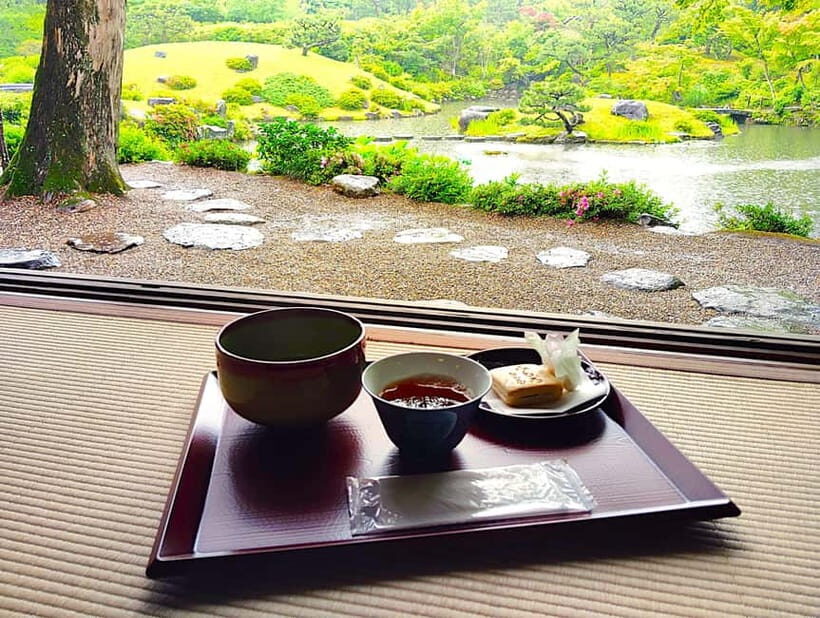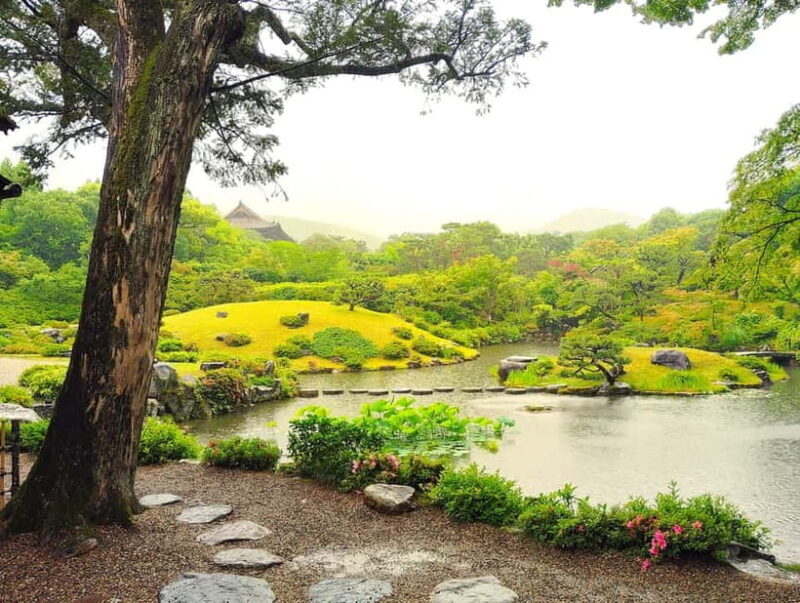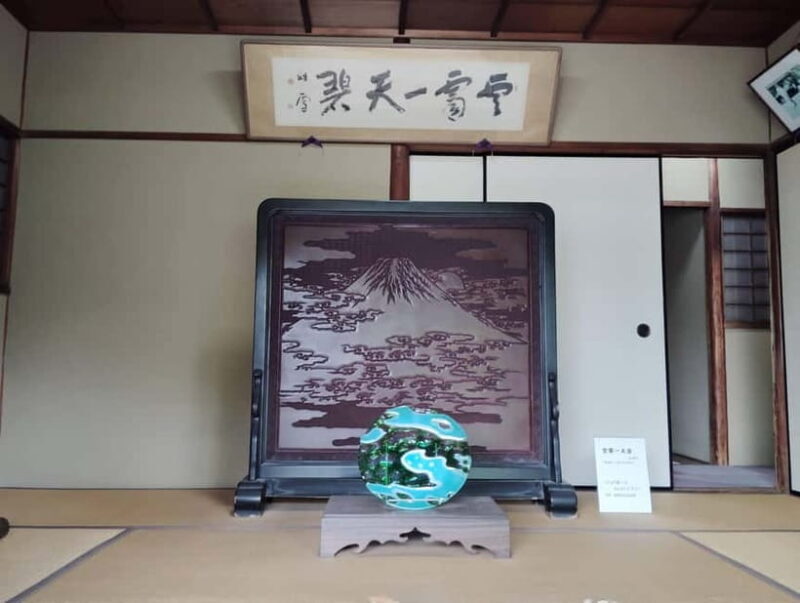Imagine wandering through a garden that balances traditional Japanese design with a touch of history, all while enjoying a calming cup of matcha tea with an unbeatable view. For $76 per person, this guided tour offers a beautifully curated look at Isuien Garden in Nara, combined with a tranquil tea ceremony that completes the experience. Led by friendly guides, you’ll explore the garden’s harmonious layout, learn about its clever use of shakkei (borrowed scenery), and savor a moment of Zen as you sip green tea overlooking Mount Mikasa and Todai-ji’s Great South Gate.
What makes this tour especially appealing is the skillful way it combines educational insights with sensory enjoyment. We especially appreciated how the guide explained the garden’s design principles, giving us a deeper appreciation for the artistry behind Japanese landscape architecture. Plus, the tea ceremony, held in a setting with panoramic views, provided a peaceful pause in our busy sightseeing day.
One aspect to keep in mind is that transportation to and from the garden isn’t included, so you’ll want to plan your route accordingly. This tour suits visitors who love authentic cultural experiences—those eager to understand Japanese aesthetics, enjoy scenic beauty, and indulge in a quiet moment of reflection amid nature. It’s perfect for travelers who appreciate guided insights and are interested in a peaceful, immersive activity rather than a quick look.
Key Points

- Expert Guidance: Knowledgeable guides explain the history, design, and meaning behind Isuien’s features.
- Stunning Views: Savor picturesque vistas of Mount Mikasa and Todai-ji from within the garden.
- Cultural Insights: Learn about shakkei (borrowed scenery) and traditional garden design from a local guide.
- Authentic Experience: Participate in a traditional matcha tea ceremony in a scenic setting.
- Balanced Style: The garden blends Edo and Meiji periods in its design, offering a layered aesthetic.
- Flexible Booking: You can reserve now and pay later, with cancellations allowed up to 24 hours in advance.
An In-Depth Look at the Isuien Garden Tour

When we first arrived at Isuien Garden, we were immediately struck by its peaceful layout and the way it masterfully combines elements from two distinct eras—Edo and Meiji. This blending creates a layered, textured environment that appeals both visually and historically. The guided tour begins at the entrance, where our guide, who spoke clearly and enthusiastically, greeted us with a welcoming smile. She set the tone for what would be a relaxed yet informative stroll through a garden that feels more like a living piece of art than just a park.
Planning more time in Nara? We've covered other experiences worth considering.
The Garden’s Design and Its Significance
As we moved through the pathways, our guide explained the significance of how the stones were placed, how water flowed through carefully positioned channels, and how the space was designed to evoke serenity and harmony. One of the main features we loved was the explanation of shakkei—the concept of “borrowed scenery.” From the garden’s rear section, the views of Todai-ji’s Great South Gate and Mount Mikasa seamlessly integrate into the landscape, giving the impression that the garden extends into the surrounding scenery, rather than being confined by walls or fences.
The guide pointed out how this technique makes the garden appear larger and more expansive, creating a sense of connection with the wider landscape. We loved how the distant mountains and temple gate seem to be part of the garden’s own composition, offering a perfect example of Japanese aesthetic ideals—balance, naturalness, and subtlety.
The Walk Through the Gardens
The layout is a thoughtful mix of formal and informal areas. You’ll pass by tranquil ponds, stone lanterns, and winding paths that invite quiet contemplation. The garden’s design creates a visual dialogue between the different elements—water, stones, trees—each placed with great care to evoke a sense of timelessness. Our guide shared stories about the Edo and Meiji influences, helping us understand how Japanese gardens evolved over the centuries.
The View of Mount Mikasa and Todai-ji
One of the highlights is the view of Todai-ji’s Great South Gate, which is visible from the garden’s highest points. Mount Mikasa, with its lush greenery, also frames the scenery beautifully. From certain vantage points, the scene felt almost cinematic, like stepping into a Japanese painting. It’s worth noting that these views are an intentional part of the garden’s borrowed scenery, blending natural and man-made elements into one harmonious picture.
More Great Tours NearbyThe Matcha Tea Ceremony
After the walk, the tour concludes in a traditional tea house that faces the garden. Here, we participated in a matcha tea ceremony—a calming, meditative process that emphasizes mindfulness and appreciation of the moment. The tea was prepared expertly by our guide, who explained the significance of each step, from whisking the powder to the proper way to enjoy the tea.
Sipping the rich green matcha while gazing out over the garden’s scenic views was a moment of genuine tranquility. Many reviews mention how this part of the tour allows you to fully absorb the atmosphere, turning sightseeing into a peaceful, sensory experience.
Practical Details and Value
The entire experience lasts around two hours and is best suited for those interested in cultural and aesthetic education. The tour is offered in English and Japanese, ensuring clear explanations for international visitors. While transportation isn’t included, the meeting point is straightforward to find in front of the garden entrance, marked by the guide’s yellow “DeepExperience” sign.
The cost of $76 is reasonable, considering the guided tour, expert commentary, and the authentic tea ceremony included. Compared to other experiences, this tour offers a combination of education, scenic beauty, and culture that’s hard to beat at this price point. It’s especially valuable if you’re eager to understand Japanese garden principles and enjoy peaceful, scenic moments in a historic setting.
Who Will Love This Tour?

If you’re someone who appreciates authentic cultural activities and enjoys learning about design and history, this tour is ideal. It’s especially suited for garden lovers, history buffs, or anyone seeking a quiet, contemplative experience amid stunning scenery. Travelers who want a deeper understanding of Japanese aesthetics will find this tour particularly rewarding.
This experience also benefits those who prefer guided insights rather than wandering alone, as the explanations deepen appreciation. And if you’re a fan of matcha or traditional tea ceremonies, the ending will surely be a highlight.
However, if you prefer more active or fast-paced tours, or if you’re on a tight schedule with no time for a leisurely stroll, you might find this experience too slow-paced. Also, if transportation logistics aren’t convenient for you, plan ahead to reach the meeting point comfortably.
Frequently Asked Questions

Is transportation to the garden included?
No, transportation to and from the garden is not included, so you’ll need to plan how to get there.
How long does the tour last?
The tour is approximately two hours, including the garden walk and tea ceremony.
What languages are available for the tour?
The tour is offered in both English and Japanese, ensuring clarity for international visitors.
What is included in the price?
The guided tour of Isuien Garden and the matcha tea ceremony are included.
Can I cancel the reservation?
Yes, you can cancel up to 24 hours in advance for a full refund.
Is this tour suitable for all ages?
Yes, it’s suitable for most ages, especially those interested in cultural and scenic experiences.
Do I need prior knowledge of Japanese gardens?
No, the guide will explain the key concepts, making it accessible for everyone.
Are there any physical requirements?
The garden involves walking on paths and gentle slopes; comfortable shoes are recommended.
What should I wear?
Dress comfortably and appropriately for the weather, as you’ll spend time outdoors and in a traditional tea house.
Concluding Thoughts

For those seeking a peaceful escape into Japanese garden beauty combined with cultural learning, this tour strikes a great balance. It offers a chance to see classic landscape design principles in action while enjoying a serene tea ceremony with views that seem pulled from a painting. The knowledgeable guides enhance the experience, making complex concepts understandable and engaging.
The experience is ideal for cultural explorers, garden enthusiasts, and anyone wanting to deepen their understanding of Japanese aesthetics without sacrificing comfort or authenticity. The combination of scenic views, insightful commentary, and a calming tea ritual makes this a memorable part of any trip to Nara.
While it’s not suited for travelers craving high-energy activities, those who appreciate quiet beauty and cultural stories will find it both enriching and relaxing. It’s a gentle, beautifully curated experience that offers genuine value for those wanting to connect with Japan’s landscape and traditions in an intimate setting.
If you’re ready to see Isuien’s stunning scenery and enjoy a traditional tea ceremony, this tour offers a well-rounded, authentic look at Japanese garden artistry—worth every yen.
You can check availability for your dates here:More Tours in Nara
More Tour Reviews in Nara
More Nara experiences we've covered
- Nara: Onigiri Making Experience
- Kimono rental
- Nara – Highlights Bike Tour
- Private Nara Tour: Temples, Deer, and Photo Spots
- Half-Day Private Guided Tour to Nara City
- Relax in Nara: Deer Park, Todai-ji Temple and Merchants’ Town
- Nara: Mt. Ikoma Guided Hiking Tour with Cable Car and Views
- NaraPrivate Tea Ceremony(Max 5 ppl) -Master Matcha Making-
- Exploring Nara
- Nara Early Bird Tour (Kyoto Departure Option Available)
- Nara Todaiji Lazy Bird Walking Tour
- Private 3-Hour UNESCO Heritage Sites & Deer Park Tour
